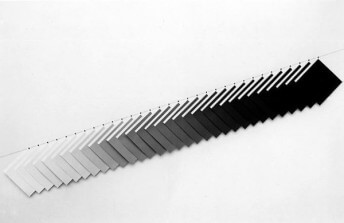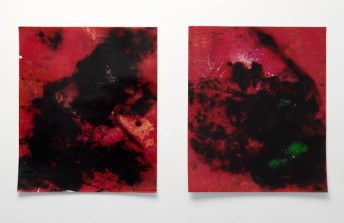Merging Science and Photography - The Art of Fabian Oefner
Aug 7, 2017
Chances are you have seen the work of Swiss photographer Fabian Oefner at some point in recent years. Since he opened his professional photography studio in 2013, his magical-looking photographs capturing scientific phenomena frozen in time have appeared on the BBC, in the Washington Post, and in magazines like Wired, Der Spiegel and national Geographic, among many other outlets. Despite their mystics-seeming aspects, the images Oefner makes actually come about through quite straightforward processes. In the confines of his workspace he simply sets natural forces into motion then, at the perfect moment, freezes them, allowing spectators to see what is normally invisible: the ephemeral beauty of nature in motion.
Photographic Paintings
In this series, begun in 2016, Oefner utilizes melted bismuth ore to capture the fleeting beauty of transitory color shifts that occur when hot metal cools. To start, he melts the metal ore in a large pan. He then uses a spatula to scrape off the top layer of the molten metal, exposing the layers underneath to the air, which causes them to cool. The air causes a rainbow of colors to flash across the surface of the bismuth, which Oefner then captures with a camera. The process is part chance, as there is no predicting what color effects are going to occur, and part control, as Oefner chooses the moment to snap the photo. The name of the series, Photographic Paintings, is derived from the idea that the work begins as a physical process of manipulating a medium then takes on a new life as a digital photograph, but then is retranslated into a physical object once again when printed.
 Fabian Oefner - Photographic Paintings series, 2016, Inkjet Print
Fabian Oefner - Photographic Paintings series, 2016, Inkjet Print
Oil Spill
For his Oil Spill series, Oefner took inspiration from a common, everyday sight that anyone who lives in a city has seen. Says Oefner, “It came to my mind when I was sitting outside my studio on a rainy day and observed a thin film of petrol on a water puddle. So I got inside again and started to recreate the setup in a more controlled environment.” That controlled environment consisted of a pool of water contained in a black pool. Oefner then introduced different oils into the water through a syringe, lighting the surface of the water and photographing the resulting compositions created as the oil spread across the surface of the pool. The iridescent, colorful patterns he captured mimic countless features of the visible universe, from the eyes of a tiny animal to a massive exploding galaxy.
 Fabian Oefner - Oil Spill series, 2016, Inkjet Print
Fabian Oefner - Oil Spill series, 2016, Inkjet Print
Paint in Motion
Abstract Expressionist artists like Jackson Pollock conveyed action and physicality in their paintings by flinging, dripping and pouring paint, using centrifugal forces to create give their works exciting, kinetic, gestural appeal. Fabian Oefner wanted to explore that same idea, but instead of studying the way flung paint looks once it lands on a surface, he wanted to capture the ephemeral beauty of paint while it is still in motion. For his series Paint in Motion, he applied various colors of paint on a spinning centrifuge the set the device in motion, sending the paint flying in every direction. He then captured the paint in mid air, offering a revelatory glimpse of the forces of Action Painting at work.
 Fabian Oefner - Paint in Motion series, 2012 - 2014, Inkjet Print
Fabian Oefner - Paint in Motion series, 2012 - 2014, Inkjet Print
Dancing Colors
In 2013, Oefner became curious about how sound would look if we could see it. His series Dancing Colors is the response to that curiosity. To investigate the audio-visual mystery, he set a thin, flat, horizontal sheet of foil atop an audio speaker. He then poured hundreds of multi-colored crystals atop the foil and send an audio signal through the speaker. As the audio hit the foil, the crystals jumped into motion revealing the physical presence of sound waves, which Oefner captured as they hung for a fraction of a second in space.
 Fabian Oefner - Dancing Colors series, 2013, Inkjet Print, 120 x 80 cm
Fabian Oefner - Dancing Colors series, 2013, Inkjet Print, 120 x 80 cm
Millefiori
The word millefiori comes from the Italian, and literally means a thousand flowers. The word was first used by glass blowers to describe a technique that results in a distinctive patters of shapes surrounded by channels of colors, as if one was looking down onto a field of blooming daisies. For his Millefiori series, Fabian Oefner created a similar type of visual effect, but through scientific means. He began with a liquid called ferrofluid, which contains iron particles and is therefore magnetic. But ferrofluid is also similar to oil, in that it does not mix with water. When ferrofluid is mixed with watercolors and then struck by a magnetic field, the ferrofluid creates distinctive black channels that connect with each other in a pattern between the pools of watercolors, resulting in a pattern quite similar to that which occurs on millefiori glass.
 Fabian Oefner - Millefiori, 2013, Inkjet Print, 120 x 80 cm
Fabian Oefner - Millefiori, 2013, Inkjet Print, 120 x 80 cm
Iridient
One of the simplest, and yet most intriguing bodies of work Fabian Oefner has created is his Iridient series. For this series, he sought to capture the fleeting beauty of soap bubbles, something almost everyone has surely witnessed at some point in life. We may have seen soap bubbles floating past us in the bathtub as a child, and wondered momentarily at the vivid colors swirling through them as they reflected the ambient light. But then they popped, vanishing in thin air. Or perhaps we have seen massive soap bubbles created by performers in the park, or even been splattered by their spray when they finally burst. In this series of photographs, Oefner allows us to experience these wondrous spectacles at our leisure, examining the fantastical array of colors and morphing organic forms that occur as they grow and float through the air, and the universe of tiny particles that explode into space when they burst, sending forth what appears to be a new galaxy of stars. These thoughts, expressed by Oefner about this series, sum up the entirety of his work: “It is intriguing how photography enables you to stop time for a moment and save it forever. I think thats what the series ultimately is about. Preserving time.
 Fabian Oefner - Iridient series, 2013-2015, Inkjet Print
Fabian Oefner - Iridient series, 2013-2015, Inkjet Print
Featured image: Fabian Oefner - Dancing Colors Series, 2013, Inkjet Print, 120 x 80 cm
All images © Fabian Oefner, all images used for illustrative purposes only
By Phillip Barcio





